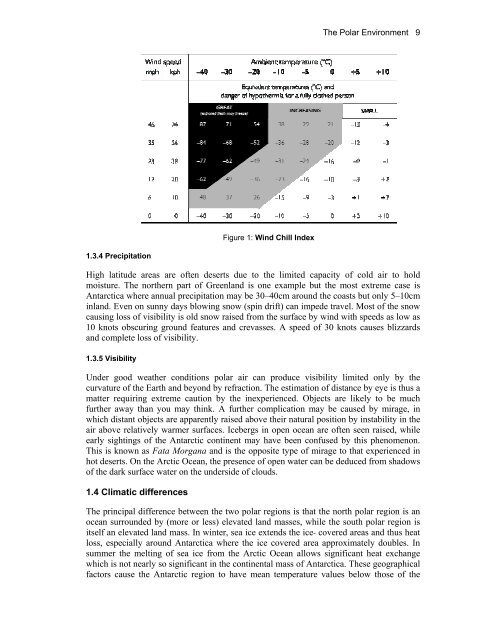Edited by Rachel Duncan 4th Edition ISBN 0-907649-91-2 London ...
Edited by Rachel Duncan 4th Edition ISBN 0-907649-91-2 London ...
Edited by Rachel Duncan 4th Edition ISBN 0-907649-91-2 London ...
You also want an ePaper? Increase the reach of your titles
YUMPU automatically turns print PDFs into web optimized ePapers that Google loves.
1.3.4 Precipitation<br />
Figure 1: Wind Chill Index<br />
The Polar Environment 9<br />
High latitude areas are often deserts due to the limited capacity of cold air to hold<br />
moisture. The northern part of Greenland is one example but the most extreme case is<br />
Antarctica where annual precipitation may be 30–40cm around the coasts but only 5–10cm<br />
inland. Even on sunny days blowing snow (spin drift) can impede travel. Most of the snow<br />
causing loss of visibility is old snow raised from the surface <strong>by</strong> wind with speeds as low as<br />
10 knots obscuring ground features and crevasses. A speed of 30 knots causes blizzards<br />
and complete loss of visibility.<br />
1.3.5 Visibility<br />
Under good weather conditions polar air can produce visibility limited only <strong>by</strong> the<br />
curvature of the Earth and beyond <strong>by</strong> refraction. The estimation of distance <strong>by</strong> eye is thus a<br />
matter requiring extreme caution <strong>by</strong> the inexperienced. Objects are likely to be much<br />
further away than you may think. A further complication may be caused <strong>by</strong> mirage, in<br />
which distant objects are apparently raised above their natural position <strong>by</strong> instability in the<br />
air above relatively warmer surfaces. Icebergs in open ocean are often seen raised, while<br />
early sightings of the Antarctic continent may have been confused <strong>by</strong> this phenomenon.<br />
This is known as Fata Morgana and is the opposite type of mirage to that experienced in<br />
hot deserts. On the Arctic Ocean, the presence of open water can be deduced from shadows<br />
of the dark surface water on the underside of clouds.<br />
1.4 Climatic differences<br />
The principal difference between the two polar regions is that the north polar region is an<br />
ocean surrounded <strong>by</strong> (more or less) elevated land masses, while the south polar region is<br />
itself an elevated land mass. In winter, sea ice extends the ice- covered areas and thus heat<br />
loss, especially around Antarctica where the ice covered area approximately doubles. In<br />
summer the melting of sea ice from the Arctic Ocean allows significant heat exchange<br />
which is not nearly so significant in the continental mass of Antarctica. These geographical<br />
factors cause the Antarctic region to have mean temperature values below those of the

















